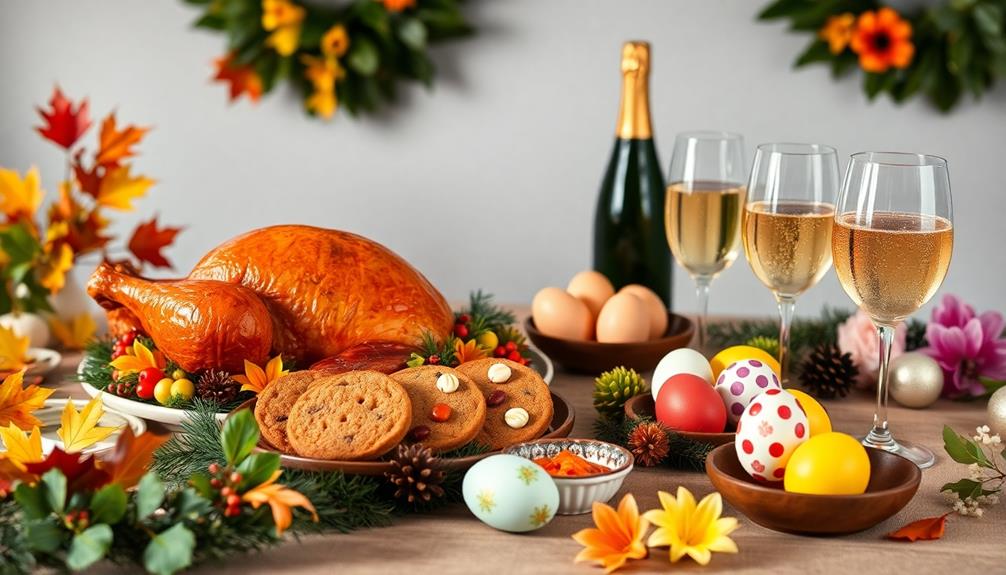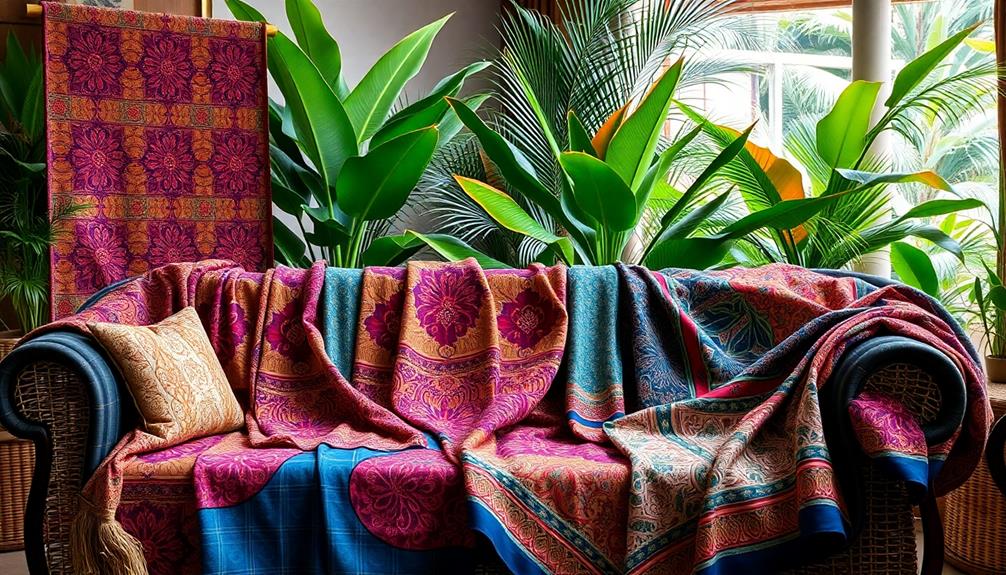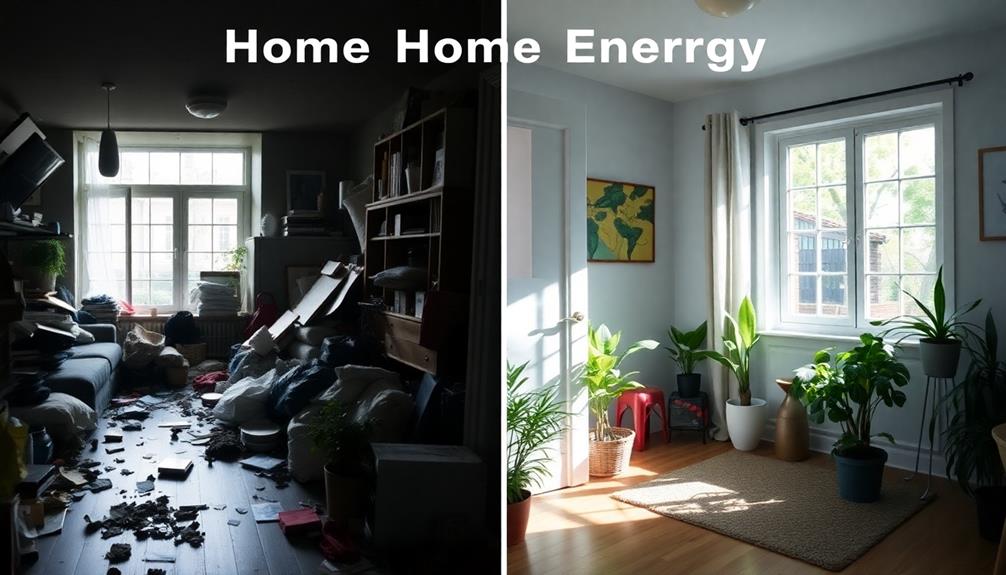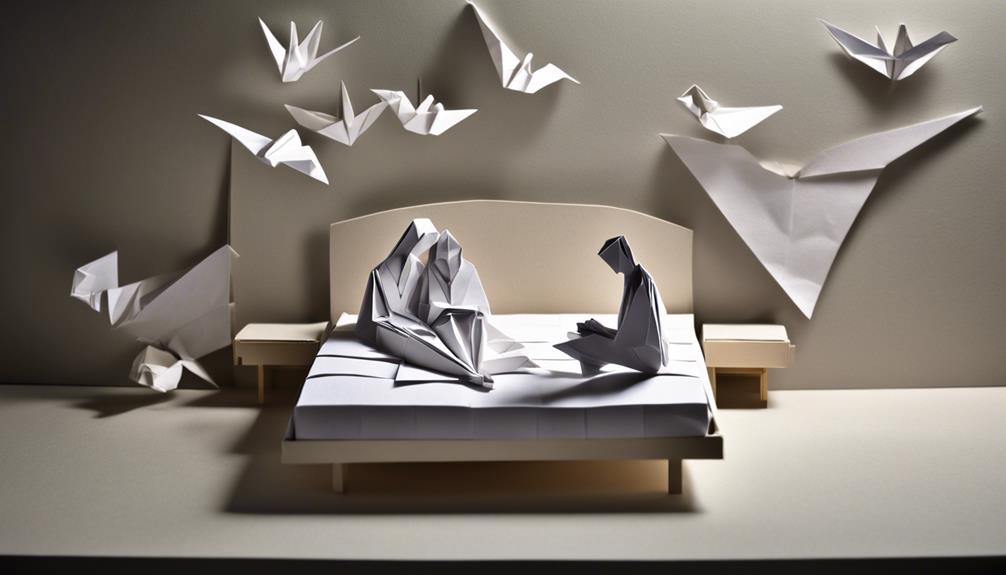Certain foods are linked to holidays because they carry deep historical and cultural significance. For instance, turkey symbolizes gratitude during Thanksgiving, while fruitcake has roots in ancient Rome. These dishes often evoke nostalgia and create emotional bonds, linking generations through shared recipes. Seasonal ingredients, like pumpkins during fall, reflect local traditions and agricultural practices. Over time, food rituals enhance community ties and celebrate cultural identity. The evolution of these culinary traditions showcases how our festive meals connect us. If you're curious about how these connections have evolved, you'll discover more intriguing insights ahead.
Key Takeaways
- Historical origins of holiday foods often stem from ancient practices and local ingredients, creating lasting associations with specific celebrations.
- Many traditional dishes carry symbolic meanings, reflecting cultural values and beliefs tied to the holidays they represent.
- Seasonal ingredients celebrate local agricultural practices, making certain foods synonymous with specific times of the year.
- Family recipes and culinary traditions are passed down through generations, linking particular foods to cultural identities and family heritage.
- Economic factors, including consumer spending patterns during holidays, influence the popularity and availability of specific festive foods.
Historical Origins of Holiday Foods
Holiday foods have rich historical origins that reflect cultural traditions and practical needs over the centuries. When you think about traditional holiday foods, many items on your Christmas dinner table have fascinating backstories.
Take fruitcake, for instance. Its roots trace back to ancient Rome, where it combined pine nuts, pomegranate seeds, and barley mash. Over time, it evolved to include dried fruits and spices, becoming a festive staple.
Similarly, many people enjoy utilizing leftovers, such as turkey sandwiches or turkey soup, after Thanksgiving, highlighting the importance of resourcefulness in holiday cooking using leftover turkey.
Christmas pudding, or plum pudding, is another dish steeped in tradition. Made with 13 ingredients symbolizing Christ and the apostles, it's a must-have for festive gatherings.
Similarly, roasting turkey for Christmas gained popularity because of its affordability and size, making it a favorite among working-class families, replacing the more expensive goose.
Mincemeat pie tells a story of resourcefulness, originating in the 16th century as a way to stretch meat supplies, blending meat with dried fruits.
Don't forget about eggnog, either; this celebratory punch dates back to the 17th century, combining milk and wine for special occasions.
Each of these traditional holiday foods adds depth to your festivities, connecting you to history and shared experiences.
Cultural Significance of Festive Meals
Throughout various cultures, festive meals hold deep cultural significance, intertwining historical events, religious beliefs, and community values. In Brazilian culture, for instance, traditional dishes like Caldeirada serve as a reminder of the country's rich maritime heritage, while festive sweets like Brigadeiro highlight the importance of celebrations and gatherings.
These traditional foods often serve as a bridge between generations, reminding you of your heritage and the stories that shape your identity. Here are three key aspects of their significance:
- Symbolism: Many dishes carry symbolic meanings. For instance, turkey during Thanksgiving represents gratitude and abundance, while latkes during Hanukkah connect to Jewish traditions and the miracle of oil.
- Seasonal Connection: Specific ingredients often reflect local agricultural practices. Foods like chestnuts during Christmas highlight the bounty of the region and celebrate seasonal harvests.
- Community Bonds: Food rituals strengthen community ties. Meals shared during celebrations, such as Kwanzaa, foster unity and create a sense of belonging, emphasizing the importance of togetherness.
These festive meals are more than just traditional recipes; they encapsulate the values, beliefs, and histories of the cultures they represent.
Food as a Symbol of Togetherness
When you gather around the table for holiday meals, you're not just sharing food; you're creating lasting memories and strengthening bonds with loved ones.
Each dish, from Thanksgiving turkey to Hanukkah latkes, reflects your cultural identity and the values that make your celebrations special.
For example, in Italian culture, dishes like Agnolotti or Pasta Alla Norma can serve as a reminder of family traditions and regional heritage.
These shared culinary experiences foster a sense of togetherness, reminding everyone of the warmth and unity that food brings.
Shared Culinary Experiences
Gathering around the table to share a meal brings people closer, transforming ordinary moments into cherished memories. During the holiday season, traditional Christmas foods play a vital role in fostering connections.
Just as with Mushroom Masala, which is often served during festive gatherings, these meals create a warmth that resonates beyond the dining experience. When you share these meals, you create more than just a feast; you build a sense of community.
Here are three ways shared culinary experiences enhance those bonds:
- Generational Connections: Unique family recipes passed down through generations serve as a bridge, linking you to your heritage and family history.
- Collective Cooking: The act of preparing meals together encourages teamwork and collaboration, making the cooking process just as enjoyable as the meal itself.
- Universal Gesture: Breaking bread during holiday festivities symbolizes goodwill and generosity, reinforcing social ties within your community.
Whether it's the aroma of latkes during Hanukkah or the warmth of tamales during Christmas in Mexico, these shared culinary experiences elevate your celebrations.
They remind you that food isn't just nourishment; it's a powerful symbol of togetherness, making each holiday gathering a memorable occasion.
Cultural Identity Through Food
Food often plays an essential role in expressing cultural identity, especially during holidays. When you gather around the table for celebrations, the dishes served aren't just meals; they're symbols of your heritage.
For instance, the preparation of tamales for Christmas in Mexico brings families together, reinforcing community values and fostering a sense of belonging. Similarly, dishes like Chilaquiles serve as a comforting breakfast that often appears during festive gatherings, further emphasizing the connection between food and celebration.
During Thanksgiving, the turkey isn't just a centerpiece; it represents unity and warmth, strengthening social bonds among loved ones. Similarly, Hanukkah latkes create shared experiences that weave collective memories within diverse cultural groups.
The unique foods enjoyed during holidays reflect regional agricultural practices and historical influences. Whether it's local seafood at coastal celebrations or specific meats in various cultures, these dishes celebrate your roots.
Even holiday-themed fast food transcends geographical boundaries, showing how food connects different cultures while preserving individual identities.
Emotional Connections Through Culinary Traditions
At the heart of every holiday celebration lies a powerful connection to culinary traditions that evoke cherished memories and emotions.
Think about how holiday foods, like fruitcake at Christmas, bring you closer to family and friends. These meals often stir feelings of nostalgia, reminding you of past gatherings and shared experiences.
In Ethiopian culture, dishes like Yetimatim Fitfit and Tej during celebrations create a vibrant atmosphere filled with connection and joy.
Here are three ways culinary traditions create emotional connections:
- Shared Experiences: Cooking and sharing meals together strengthen bonds, turning ordinary moments into lasting memories.
- Cultural Heritage: Dishes like latkes during Hanukkah connect you to your cultural roots, enriching the holiday experience and deepening your sense of belonging.
- Symbolic Joy: Certain foods symbolize the warmth and joy of celebrations, making them integral to your holiday rituals.
When you anticipate these traditional meals, you're not just looking forward to the food; you're also embracing the love and togetherness that come with them.
These culinary traditions aren't just about nourishment; they're about creating a tapestry of emotions that weave through your family's holiday celebrations, making each gathering special.
The Role of Family Recipes
Family recipes hold a special place in your holiday celebrations, connecting you to generations past.
These dishes not only reflect your cultural heritage but also evoke cherished memories that strengthen your family's bond.
For instance, enjoying traditional sweets like Qatayef during special occasions can bring back memories of past celebrations.
Legacy of Family Recipes
Nestled within the heart of every holiday celebration are the treasured family recipes that connect generations.
These unique dishes—like your grandmother's pie or a special casserole—serve not just as meals, but as a bridge to the past. For instance, traditional desserts such as Kue Putu or Dadar Gulung often evoke memories of family gatherings, enhancing both flavor and nostalgia.
When you gather with loved ones, the act of preparing and sharing these recipes fosters a sense of continuity and belonging.
Here are three ways family recipes create lasting bonds:
- Culinary Heritage: Each recipe often reflects your family's cultural roots, bringing regional flavors to your table, such as using dried fruits that highlight local agricultural products.
- Memorable Moments: Every bite carries stories, evoking strong emotional connections to past celebrations and the loved ones who shared them with you.
- Tradition-Building: As you pass down these recipes, you guarantee that future generations experience the same flavors and memories, creating a legacy that enriches family gatherings.
Incorporating these cherished dishes into your holiday traditions not only keeps memories alive but also strengthens the ties that bind you to your family's history.
Cultural Identity Through Cooking
While you prepare your holiday meal, the family recipes you cherish become more than just food; they embody your cultural identity. These recipes serve as a tangible link to your heritage, showcasing unique culinary practices passed down through generations. Each time you mix ingredients for plum pudding or roll out dough for traditional tamales, you're not just cooking; you're preserving the stories and memories tied to your ancestry.
| Dish | Cultural Significance |
|---|---|
| Plum Pudding | A festive dessert in British culture, symbolizing warmth and family unity. |
| Tamales | A staple in Mexican celebrations, representing togetherness and tradition. |
| Latkes | Celebrated during Hanukkah, reflecting Jewish heritage and history. |
| Bibimbap | A Korean dish that represents harmony and balance in flavors during holidays. |
| Samosas | Popular in South Asian cultures, symbolizing community and sharing during festivals. |
Cooking these beloved recipes during holidays fosters a sense of belonging and continuity. They become an integral part of your celebrations, reinforcing cultural ties among family members and nourishing both body and spirit.
Emotional Connections to Dishes
When you gather around the table during the holidays, the dishes served often carry deep emotional connections, transforming meals into cherished memories. Unique family recipes—like your grandmother's famous pie or your parent's legendary stuffing—create a sense of belonging and continuity.
These recipes evoke nostalgia, making them essential for special occasions. The rich flavors of traditional dishes, such as Khanom Tan (Palm Sugar Dessert), can also remind us of cultural celebrations and the joy of sharing food with loved ones.
Consider how family recipes shape your holiday experience:
- Tradition: Passing down recipes creates a bond that ties generations together, reinforcing family identity.
- Shared Experiences: The preparation of dishes, whether it's chopping candied fruit or mixing batter, fosters laughter and storytelling, making gatherings memorable.
- Symbols of Love: Certain dishes become synonymous with warmth and togetherness, elevating your holiday celebrations.
The anticipation of these beloved recipes heightens your enjoyment, wrapping you in comfort and joy. Each bite carries the weight of shared moments, whether it's a funny mishap or a heartfelt story.
Seasonal Ingredients and Local Practices
Seasonal ingredients serve as a vibrant reflection of local agricultural practices and cultural traditions, shaping holiday meals across the globe. When you think of Thanksgiving in North America, pumpkins and cranberries come to mind, as they're harvested in the fall. Similarly, in Mexico, tamales made from masa are a Christmas staple, showcasing the region's corn production.
Religious customs also dictate food choices. During Passover, families eat matzah to symbolize their ancestors' hasty escape from Egypt. Additionally, the tradition of serving turkey at Thanksgiving and ham at Christmas stems from historical availability and affordability for gatherings.
Local practices further enrich holiday menus, as seen in Italy, where panettone and torrone reflect regional baking traditions and available ingredients. Here's a quick look at some holiday foods influenced by seasonal ingredients and local practices:
| Holiday | Seasonal Ingredients |
|---|---|
| Thanksgiving | Pumpkins, Cranberries |
| Christmas | Tamales, Ham |
| Passover | Matzah |
| Italian Festivities | Panettone, Torrone |
These examples illustrate how local practices and seasonal ingredients create unique holiday experiences that resonate with cultural identity.
Evolution of Holiday Food Traditions
Holiday food traditions have changed considerably over the centuries, reflecting the dynamic interplay of cultural influences and local ingredients. In the United States, the evolution of holiday food traditions showcases this blend, deeply rooted in history and community. You'll find that various factors have shaped these traditions:
- Ancient Celebrations: Early feasting during the winter solstice aimed at celebrating the return of longer days, with communities gathering to share abundant food, reminiscent of how traditional Japanese confectionery like Dorayaki (Red Bean Pancake) has become a favorite snack during festive celebrations in Japan.
- Religious Influence: The rise of Christianity in Europe merged religious significance with culinary practices, especially evident during Christmas feasts.
- Cultural Diversity: As immigrants brought their culinary heritage to the United States, unique regional dishes emerged, such as turkey and cranberry sauce for Thanksgiving, evolving from early harvest celebrations.
This rich tapestry reflects how local agricultural products and cultural heritages shape festive food traditions. For instance, tamales are a favorite in Mexico during Christmas, illustrating the importance of local ingredients.
As you explore these holiday meals, you'll appreciate how the evolution of holiday food traditions continues to thrive, connecting past to present through shared culinary experiences.
Economic Impact of Holiday Dining
As the festive season approaches, the economic impact of holiday dining becomes increasingly evident. You mightn't realize it, but Americans spend around $200 billion annually on holiday-related food and drink. This massive spending greatly boosts the food and beverage industry, creating a ripple effect throughout the economy.
Catering services and restaurants often experience a surge in demand during this time. Many report sales increases of up to 30% compared to non-holiday periods. Local economies also benefit as holiday food markets and events generate substantial revenue for small businesses and local farmers.
You'll notice more festive pop-ups and markets, which not only support local vendors but also enhance community spirit. Additionally, food production and distribution sectors ramp up inventory and hire temporary workers to meet this heightened demand.
This seasonal spike not only drives consumer spending but also influences trends, such as the popularity of gourmet and specialty holiday food products. So, when you're enjoying your holiday meal, remember that you're contributing to a considerable economic impact that supports countless jobs and local businesses.
Health Considerations During Celebrations
Celebrations often bring an array of delicious but indulgent foods that can challenge your health goals. Traditional recipes often come packed with calories, sugar, and saturated fats.
To maintain your health during these festive times, moderation and balanced choices are essential. Here are a few tips to help you navigate holiday feasting:
- Incorporate Healthier Options: Add vegetable dishes to your spread. They can enhance your meal while offering crucial nutrients and health benefits.
- Research Substitutes: Look for alternatives to high-calorie ingredients in traditional recipes. Swapping out butter for olive oil or using whole grains instead of refined flour can make a difference.
- Practice Mindful Eating: Pay attention to portion sizes and savor each bite. This can help you enjoy festive treats without overindulging.
Frequently Asked Questions
What Are Some Foods Associated With the Holiday?
For holidays, you might enjoy turkey at Thanksgiving, ham during Christmas, latkes for Hanukkah, benne cakes at Kwanzaa, fruitcake as a festive gift, and eggnog to warm up your celebrations. Each dish brings unique joy.
Why Are Certain Foods Associated With Thanksgiving?
You might think turkey's just for Thanksgiving, but it's actually a historical nod to abundance. As you gather with loved ones, those familiar dishes bring warmth, gratitude, and a sense of tradition to your table.
Why Do We Eat Certain Foods on New Year's Day?
On New Year's Day, you eat certain foods to invite luck and prosperity into your life. Each dish carries unique symbolism, reflecting hopes for wealth, health, and happiness in the upcoming year. Enjoy these traditions!
What Is One Food Strongly Associated With an American Holiday?
Picture a golden-brown turkey, steaming beside vibrant cranberry sauce. On Thanksgiving, you gather with loved ones, sharing laughter and gratitude, as that turkey becomes the star of your feast, embodying warmth and tradition.
Conclusion
As you gather around the table during the holidays, remember that the foods you enjoy are like the threads in a tapestry, weaving together history, culture, and cherished memories. These festive meals not only satisfy your taste buds but also strengthen bonds with loved ones. Embracing traditions and sharing family recipes can deepen your connections, making each celebration more meaningful. So, savor every bite and celebrate the rich tapestry of flavors that bring everyone together.









